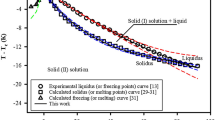Abstract
As a solution theory, Raoult’s law is commonly used to estimate the activities of solutes and solvents of comparable molecular sizes while the Flory–Huggins (F–H) model is used for the activities of small liquids in high polymers. For a great many systems where the solute and solvent differ only moderately in molecular size (e.g., by 4–10 times), there has been no confirmed choice of a preferred model; examples of such systems are those of ordinary organic compounds in liquid triolein (MW = 885.4 g·mol−1) and poly(propylene glycol) (PPG) (MW = ~1,000 g·mol−1). The observed nearly athermal solubilities of many nonpolar organic solids in these solvents provide unique experimental data to examine the merit of a solution model. As found, Raoult’s law underestimates widely, and the F–H model underestimates slightly, the solid solubilities in triolein and PPG because these models underestimate the solution entropy for these solute–solvent pairs. To rectify this problem, the molecular segments of a large sized liquid solvent (e.g., triolein) are assumed to act as independent mixing units to increase the solute–solvent mixing entropy. This adjustment leads to a modified F–H model in which the “ideal” or “athermal” solubility of a solid in volume fraction, at a particular temperature, is equal to the solid’s activity at that temperature. Results from other studies give further support for the modified F–H model to interpret the partition data of compounds with organic solvents.

Similar content being viewed by others
References
Chiou, C.T.: Partition and Adsorption of Organic Contaminants in Environmental Systems. Wiley, Hoboken (2002)
Hildebrand, J.H., Prausnitz, J.M., Scott, R.L.: Regular and Related Solutions. Van Nostrand Reinhold Co., New York (1970)
Flory, P.J.: Thermodynamics of high polymer solutions. J. Chem. Phys. 10, 51–61 (1941)
Flory, P.J.: Principles of Polymer Chemistry. Cornell University Press, Ithaca (1953)
Flory, P.J.: Thermodynamics of polymer solutions. Trans. Faraday Soc. 49, 7–29 (1970)
Huggins, M.L.: Thermodynamic properties of solutions of long-chain compounds. Ann. N. Y. Acad. Sci. 43, 1–32 (1942)
Gee, G., Treloar, L.R.G.: The interaction between rubber and liquids. 1. A thermodynamic study of the system rubber–benzene. Trans. Faraday Soc. 38, 147–165 (1942)
Chiou, C.T.: Partition coefficients of organic compounds in lipid–water systems and correlations with fish bioconcentration factors. Environ. Sci. Technol. 19, 57–62 (1985)
Chiou, C.T., Manes, M.: Application of the Flory–Huggins theory to the solubility of solids in glyceryl trioleate. J. Chem. Soc. Faraday Trans. I 82, 243–246 (1986)
Chiou, C.T., Schmedding, D.W., Manes, M.: Improved prediction of octanol–water partition coefficients from liquid–solute water solubilities and molar volumes. Environ. Sci. Technol. 39, 8840–8846 (2005)
Shinoda, K., Hildebrand, J.H.: The solubility and entropy of solution of iodine in octamethylcyclotetrasiloxane. J. Phys. Chem. 61, 789–791 (1957)
Shinoda, K., Hildebrand, J.H.: The solubility and entropy of solution of iodine in n-C7F16, c-C6F11CF3, (C3F7COOCH2)4C, c-C4Cl2F6, CCl2FCClF2 and CHBr3. J. Phys. Chem. 62, 292–294 (1958)
Mackay, D., Shiu, W.Y., Ma, K.-C.: Illustrated Handbook of Physical–Chemical Properties and Environmental fate for Organic Chemicals—Monoaromatic Hydrocarbons, Chlorobenzenes, and PCBs, vol. 1. Lewis, Boca Raton (1992)
Mackay, D., Shiu, W.Y., Ma, K.-C.: Illustrated Handbook of Physical–Chemical Properties and Environmental Fate for Organic Chemicals—Polynuclear Aromatic Hydrocarbons, Polychlorinated Dioxins, and Dibenzofurans, vol. 2. Lewis, Boca Raton (1992)
Mackay, D., Shiu, W.Y., Ma, K.-C.: Illustrated Handbook of Physical–Chemical Properties and Environmental Fate for Organic Chemicals—Pesticide Chemicals, vol. 5. Lewis, Boca Raton (1997)
Acree, W.E.: Heats of fusion of some organic compounds. In: Weast, R.C. (ed.) CRC Handbook of Chemistry and Physics, p. C-666. CRC, Boca Raton (1988)
Neau, S.H., Flynn, G.L.: Solid and liquid heat capacities of n-alkyl para-aminobenzoates near the melting point. Pharm. Res. 7, 1157–1162 (1990)
Chiou, C.T., Porter, P.E., Schmedding, D.W.: Partition equilibria of nonionic organic compounds between soil organic matter and water. Environ. Sci. Technol. 17, 227–231 (1983)
Chiou, C.T., Kile, D.E., Malcolm, R.L.: Sorption of vapors of some organic liquids by soil humic acid and its relation to partitioning of organic compounds in soil organic matter. Environ. Sci. Technol. 22, 298–303 (1988)
Acknowledgments
This work was supported in part by National Cheng Kung University (D101-33B01) and by National Science Council of Taiwan (NSC 99-2221-E-006-053). We thank Prof. Milton Manes, Professor Emeritus, Kent State University (Kent, OH, USA) and Prof. Jen-Feng Kuo, National Cheng Kung University (Tainan, Taiwan) for valuable comments and discussion.
Author information
Authors and Affiliations
Corresponding authors
Rights and permissions
About this article
Cite this article
Hung, WN., Lin, TF. & Chiou, C.T. Solution Models for Binary Components of Significantly Different Molecular Sizes. J Solution Chem 42, 1438–1451 (2013). https://doi.org/10.1007/s10953-013-0041-7
Received:
Accepted:
Published:
Issue Date:
DOI: https://doi.org/10.1007/s10953-013-0041-7




